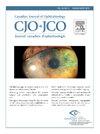急诊眼科患者视网膜下腔炎的病因及视网膜下腔炎的特征。
IF 3.3
4区 医学
Q1 OPHTHALMOLOGY
Canadian journal of ophthalmology. Journal canadien d'ophtalmologie
Pub Date : 2025-02-01
DOI:10.1016/j.jcjo.2024.05.003
引用次数: 0
摘要
目的:研究急性未分化视网膜下腔炎的病因,并更好地描述视网膜下腔炎的特征:方法:从2015年1月至2022年1月期间眼科急诊就诊的患者中,以及从2008年1月至2022年1月期间3925名就诊患者的葡萄膜炎数据库中,回顾性地确定了视网膜下腔炎患者。359名患者的375只眼睛共发生了426次眼球震颤,每位患者的病历都进行了审查:结果:总共有 222 次眼球震颤由葡萄膜炎引起,204 次由非葡萄膜炎引起。最常见的眼睑下垂原因是 HLA-B27 相关性葡萄膜炎,共有 146 名患者(34.3%)发病。其次是感染性角膜炎(125 名患者,占 29.3%)和眼底病(63 名患者,占 14.8%)。与非葡萄膜炎视力减退症患者相比,葡萄膜炎患者往往更年轻(p < 0.001),更可能是男性(p < 0.0001),初始和最终视力更好(p < 0.001),眼压更低(p = 0.030):结论:约一半的视网膜下囊炎病例继发于葡萄膜炎,其中大部分与 HLA-B27 相关,预后良好;另一半继发于感染性角膜炎和眼内炎,预后较差。本文章由计算机程序翻译,如有差异,请以英文原文为准。
Etiology of hypopyon in patients presenting acutely to the emergency eye department and characteristics of hypopyon uveitis
Objective
To examine the etiology of undifferentiated hypopyon presenting acutely and to better characterize hypopyon uveitis.
Methods
Patients with hypopyon were retrospectively identified from presentations to the emergency eye department between January 2015 and 2022 and also from a uveitis database of 3,925 patients seen between January 2008 and January 2022. A total of 426 episodes of hypopyon occurred in 375 eyes in 359 patients, and medical records were reviewed for each patient.
Results
In all, 222 hypopyon episodes were due to uveitis, and 204 were due to nonuveitic causes. The most common cause of hypopyon was HLA-B27-associated uveitis in 146 patients (34.3%). The next most common causes were infectious keratitis in 125 patients (29.3%) and endophthalmitis in 63 patients (14.8%). Compared with those presenting with nonuveitic hypopyon, patients with uveitis tended to present younger (p < 0.001), were more likely to be male (p < 0.0001), had better initial and final visual acuities (p < 0.001), and had lower intraocular pressures (p = 0.030).
Conclusion
About half of the cases of hypopyon were secondary to uveitis, most of them being associated with HLA-B27 conditions with a good prognosis, and the other half were secondary to infectious keratitis and endophthalmitis with a poor prognosis.
Objectif
Examiner l’étiologie de l'hypopyon indifférencié dans sa présentation en aigu et mieux caractériser l'hypopyon secondaire à l'uvéite.
Méthodes
Des patients qui présentaient un hypopyon ont été recensés rétrospectivement après avoir été examinés au service des urgences ophtalmologiques entre janvier 2015 et 2022, de même qu'au sein d'une base de données sur l'uvéite comportant 3925 patients examinés de janvier 2008 à janvier 2022. Au total, 426 épisodes d'hypopyon sont survenus dans 375 yeux (359 patients). On a passé en revue les dossiers médicaux de chacun de ces patients.
Résultats
Globalement, 222 épisodes d'hypopyon avaient été causés par une uvéite, et 204, par une pathologie autre que l'uvéite. La cause la plus fréquente d'un hypopyon était l'uvéite associée à l'antigène HLA-B27 (146 patients; 34,3 %). Viennent ensuite la kératite infectieuse (125 patients; 29,3 %) et l'endophtalmie (63 patients; 14,8 %). Comparativement aux patients présentant un hypopyon sans lien avec une uvéite, les patients atteints d'une uvéite avaient tendance à être plus jeunes (p < 0,001), étaient plus susceptibles d’être de sexe masculin (p < 0,0001), avaient une meilleure acuité visuelle initiale et finale (p < 0,001) et avaient une pression intraoculaire moins élevée (p = 0,030).
Conclusion
Environ la moitié des cas d'hypopyon étaient secondaires à une uvéite, laquelle était le plus souvent associée à l'antigène HLA-B27, et de pronostic favorable. Dans l'autre moitié des cas, l'hypopyon était secondaire à une kératite infectieuse ou à une endophtalmie, et de pronostic médiocre.
求助全文
通过发布文献求助,成功后即可免费获取论文全文。
去求助
来源期刊
CiteScore
3.20
自引率
4.80%
发文量
223
审稿时长
38 days
期刊介绍:
Official journal of the Canadian Ophthalmological Society.
The Canadian Journal of Ophthalmology (CJO) is the official journal of the Canadian Ophthalmological Society and is committed to timely publication of original, peer-reviewed ophthalmology and vision science articles.

 求助内容:
求助内容: 应助结果提醒方式:
应助结果提醒方式:


